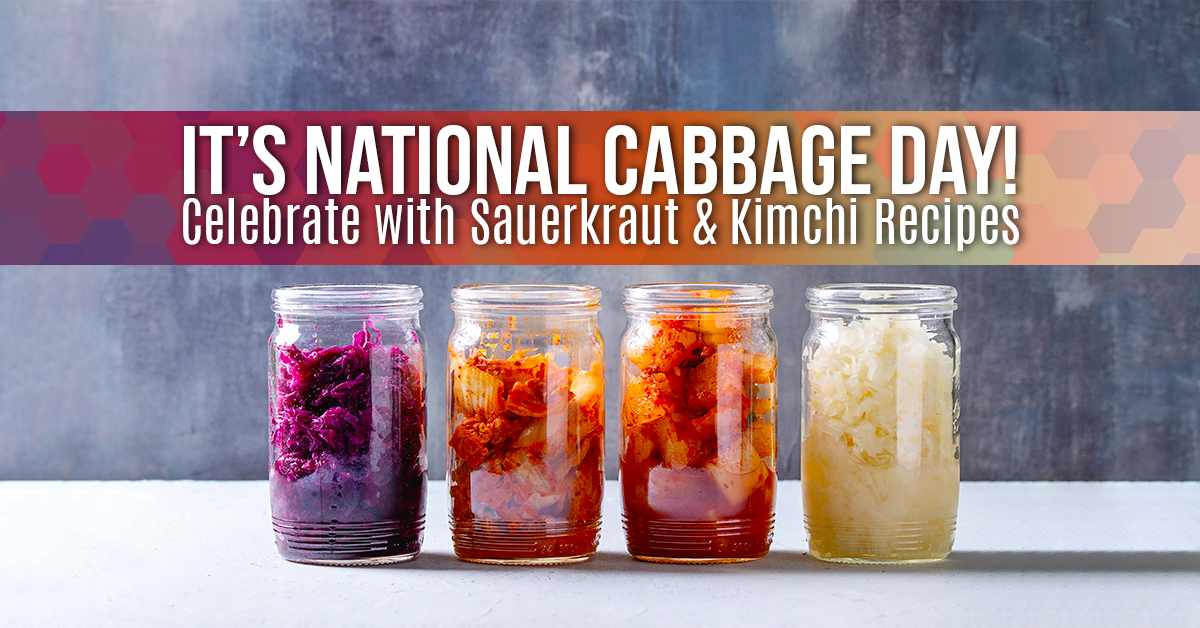
Happy National Cabbage Day! With this fabulous calendar holiday, let’s celebrate with some delicious Sauerkraut and Kimchi recipes! Before we get started, it’s important to learn a little more about fermented foods. What are fermented foods? Are they even good for you? Can you eat them? Should you eat them? In many ways, fermented foods can seem a little scary, or overwhelming if you are not used to eating them. They tend to have a really intense taste, however, so worth trying!
Food fermentation is a process that takes advantage of bacteria to alter ingredients. As mentioned before, this process often leads to fairly strong tastes, textures, and flavors. The bacteria partially breaks down the food, which is what creates this flavor and provides various health benefits too! The process in which the bacteria breaks down the food allows for the nutrients to be easier to digest, which in turn, gives you access to more nutrients than normal. Discussed further in the Holistic Nutrition: Raw Food Cuisine class offered here at Southwest Institute of Healing Arts, research suggests that this is a great approach for health overall and has many potential health benefits for humans.
Now, let’s dive into the recipes!
|
Sauerkraut 1 head of cabbage + 2 tsp. sea salt = 1 quart of kraut
1. Remove a few of the outer leaves and set aside. Discard any that have mold on them. 2. Quarter each head of cabbage and remove the core. Slice with a knife, mandolin, or shredding plate on a food processor. 3. Transfer to a large bowl and add salt. 4. Massage the cabbage until water begins to release. Allow to sit for 10 minutes or more and then massage again until it gets very watery. Repeat a few times until the cabbage is very juicy. 5. Transfer the cabbage to a container and pack very firmly so that the cabbage is fully submerged in water. If unable to get enough liquid, you can create a brine to cover the cabbage. See brine recipe in another recipe this week. 6. Pack your shredded cabbage into your glass container using your fist or Vitamix tamper to pack the cabbage into the jar and to ensure all air pockets are out. 7. Place your reserved leaves on top of the cabbage, letting the leaves extend partially up the sides of the jar. 8. Put a weight on the leaves, such as a jar filled with water or a clean, sanitized rock or weight bought online for this process. Make sure the cabbage is fully submerged. 9. Cover with a clean towel and place in the corner of your kitchen. 10. Ferment at room temperature for 4-10 days, up to 4 weeks depending on how tart you like it and how warm the environment is. If too warm, it will ferment very quickly. Do not store below 65 degrees or it will not ferment. 11. For the first 2 days, when you remember or a few times a day, gently press on the weight to keep the sauerkraut packed firmly. You will notice within the first day or two fermentation bubbles forming in the brine. It is also normal for slime to form on the surface sometimes. Just scrape off as much as you can. As long as the kraut is submerged in the brine, it will not be affected. 12. Taste your kraut every few days for flavor. Once it is to your liking, remove the top leaves and weight and add a regular lid or place in a clean glass bowl. It can last several weeks in the refrigerator. 13. Other veggies can be added to your kraut before you ferment, such as shredded carrots, beets, turnips, onions, or even apples, as well as seasonings such as ginger, dill, bay leaves, or caraway seeds. Resource: Going Raw by Judita Wignall |
|
Kimchi (Going Raw by Judita Wignall; page 166.)
2 heads Napa (Chinese) cabbage 3 large carrots 1 yellow onion, cut into 1/8th inch thick half moons 1 medium size daikon radish, cut into 1/8th inch thick half moons 5 cloves garlic, coarsely chopped 2 inches fresh ginger, peeled and finely grated 1 Tablespoon sea salt 2 teaspoons red pepper flakes
1. Remove a few of the outer leaves and set aside. 2. Use a knife to slice the leafy parts of the cabbage into 3/8th inch ribbons and set aside. 3. Add the carrots, onion, daikon, garlic, and ginger. 4. Massage the salt into the mixture for a few minutes. Allow to sit for 10 minutes or more and then massage again until the mixture is very juicy. 5. Add in the red pepper flakes and mix well. No need to massage, leaves will become too mushy. Pack the mixture firmly into jars and top with the reserved outer cabbage leaves. Put a smaller jar or weight on top and press down. Make sure the cabbage is fully submerged. 6. Cover with a clean towel and place in a cool place on the counter out of the sun for 1-2 weeks. 7. For the first 2 days, when you remember or a few times a day, gently press on the weight to keep the sauerkraut packed firmly. You will notice within the first day or two fermentation bubbles forming in the brine. It is also normal for slime to form on the surface sometimes. Just scrape off as much as you can. As long as the kimchi is submerged in the brine, it will not be affected. 8. Taste your kimchi every few days for flavor. Once it is to your liking, remove the top leaves and weight and add a regular lid or place in a clean glass bowl. It can last several weeks in the refrigerator. 9. Other options to add to your kimchi are green onion, jalapeno pepper, watermelon radishes, cauliflower, or broccoli. |
|
2% Brine: 1 cup water: 5 grams salt / 2 cups water: 10 grams salt / 3 cups water: 15 grams salt / 1 quart (4 cups) water: 19 grams salt (4 grams = 1 teaspoon) |
There seems to be a calendar holiday for everything now! National Cabbage day…what’s next? Drink wine day? Oh yeah…it is! With these delectable recipes, you are sure to live this Holiday to the fullest! Fermented foods have been in the human diet for a long time. With their strong flavors and great nutrients, they serve your gut microbiome and overall health! Interested in learning more about Holistic Nutrition? Check out our programs at SWIHA!


